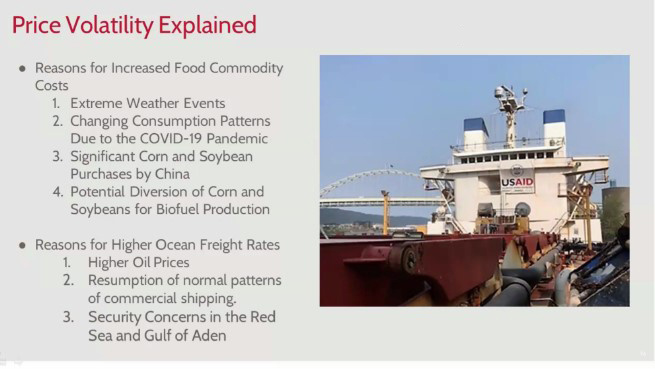 Contributing factors include weather, shipping, and security concerns
Contributing factors include weather, shipping, and security concerns
Jun 18, 2021
WASHINGTON, DC -- On June 14, the Food Aid Consultative Group (FACG) held its summer meeting to review policy priorities and program updates. FACG is a public/private forum mandated in the Farm Bill to provide a platform for U.S. government agencies to interact with private sector counterparts including private voluntary organizations (PVOs), agricultural trade groups, and maritime interests, on food assistance priorities. This was the first meeting under the Biden Administration.
While several ongoing humanitarian crises continue to receive significant attention, there were a number of new initiatives introduced to the agricultural trade community that hint at a change in resource allocation. The COVID-19 pandemic continues to have an effect on global food assistance and several new concerns will likely impact future programming.
The dire food security outlook in Yemen remains a top food aid priority as the situation is now compounded by COVID-19. Officials from the U.S. Agency for International Development (USAID) and the U.S. Department of Agriculture (USDA) also outlined new funding allocations and priority assistance for the people of Tigray, Ethiopia, in response to civil conflict and a severe humanitarian crisis there. Another priority area in the coming year will be food assistance to Madagascar as southern Madagascar is on the verge of a famine due to a severe drought impacting more than one million people.
“The call to provide rice in response to global hunger will remain strong in the next year,” said Rebecca Bratter, USA Rice food aid consultant who attended the meeting. “USDA reported that the main commodity used in more than 50 percent of its McGovern Dole School Feeding (MGD) programs was rice, both long grain and fortified. This trend will likely continue as almost all MGD grant recipients in 2020 utilized rice or fortified rice in their school feeding programs.”
Other new priority areas outlined by USAID and USDA included ongoing work on a new end-to-end commodity traceability system to improve the flow of food aid and achieving environmentally stable supply chains.
Speakers noted the price volatility of commodities used in food aid, and the need to provide new funding to food assistance programs in the Golden Triangle of Central America (Honduras, Guatemala, and El Salvador) as part of the Biden Administration’s immigration reform initiative.
“Compared to some other commodities, rice has fared relatively well on the price front,” said Bratter. “Implementing agencies, such as the World Food Programme, spec commodities based on price and we know rice is used in a lot of food assistance recipient countries. USA Rice will continue to monitor these developments and provide updates as situations evolve.”